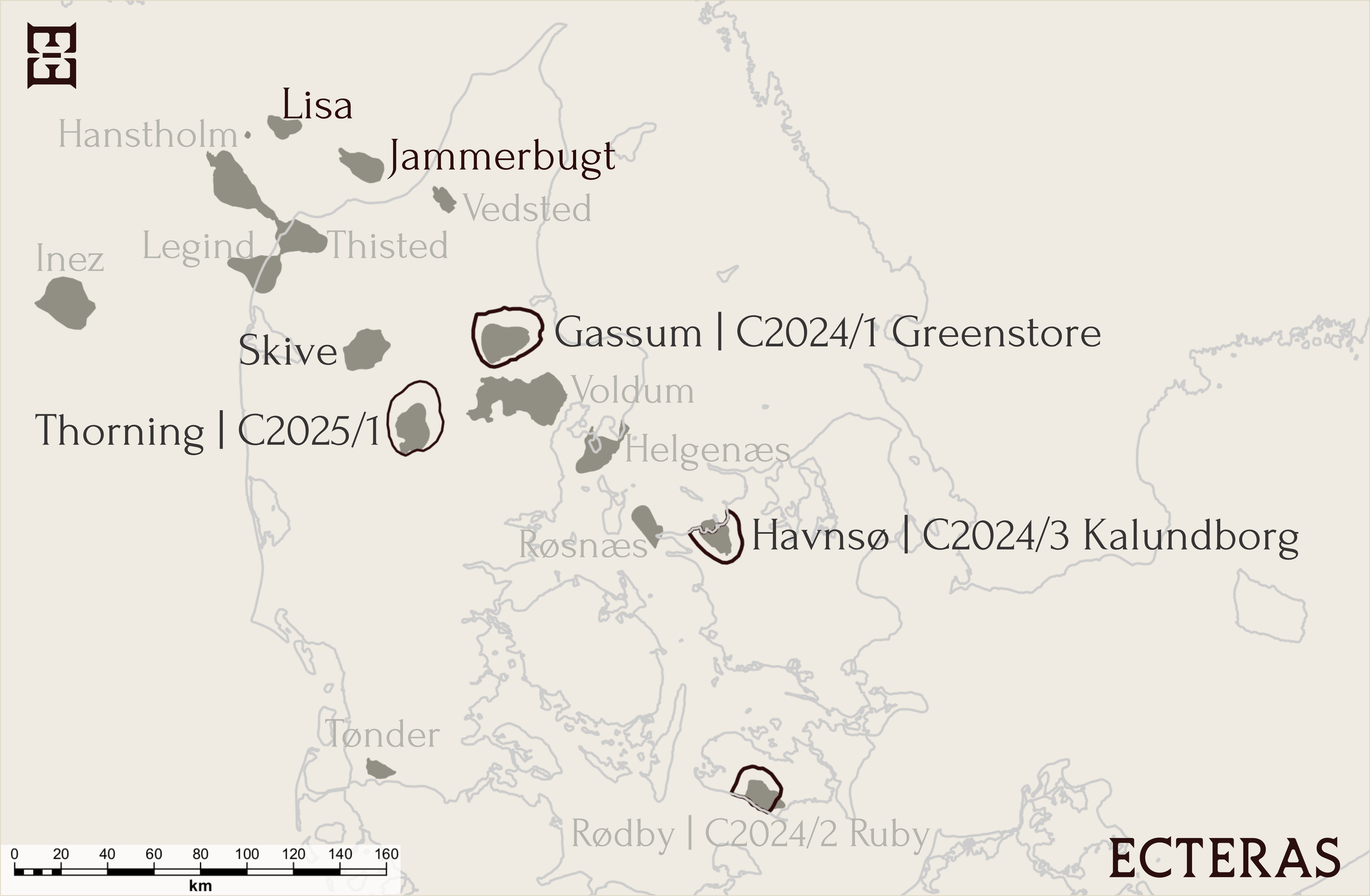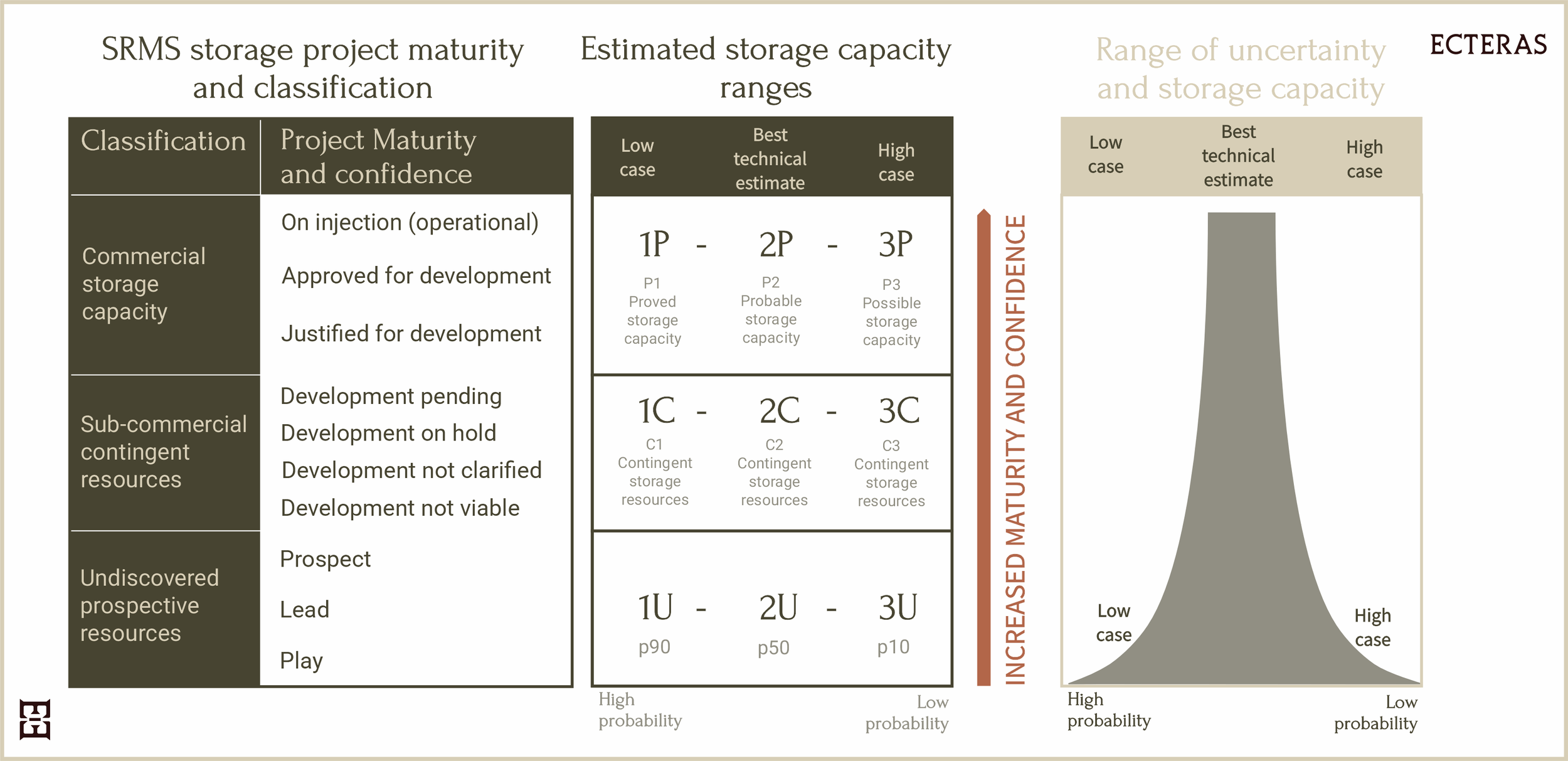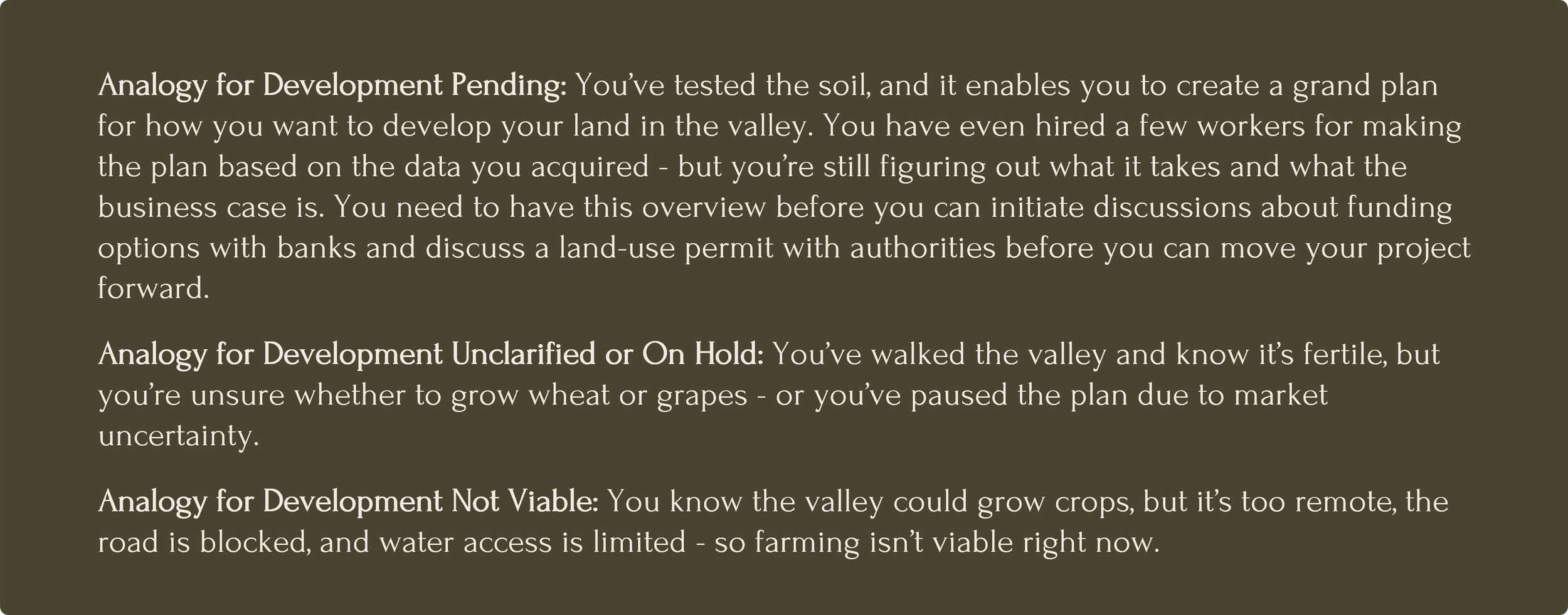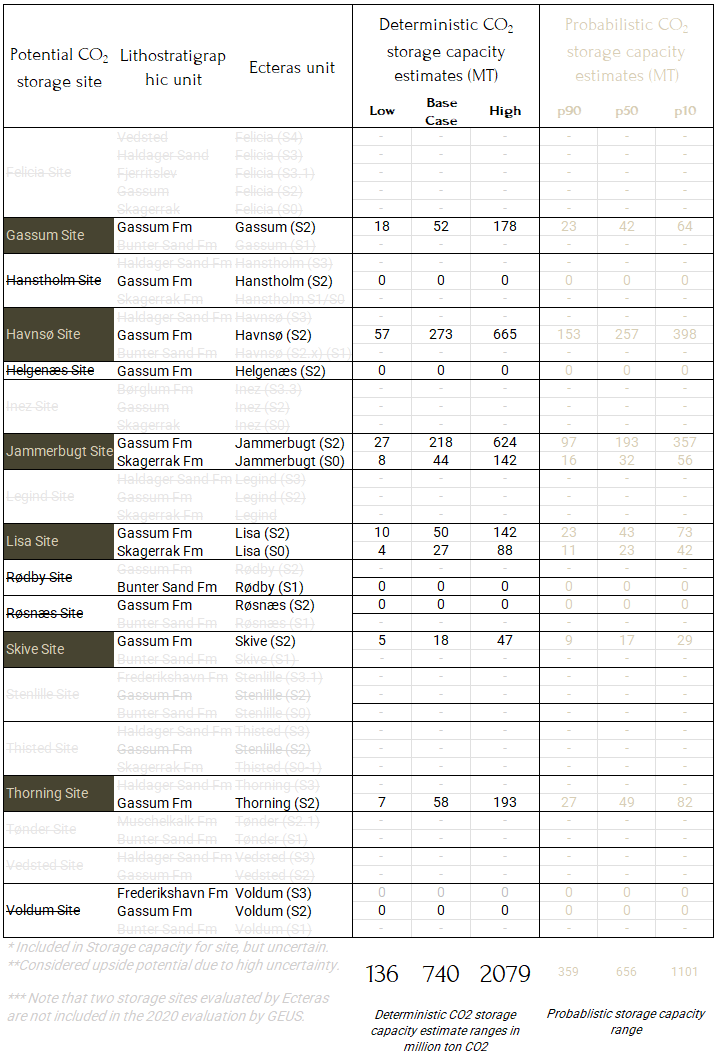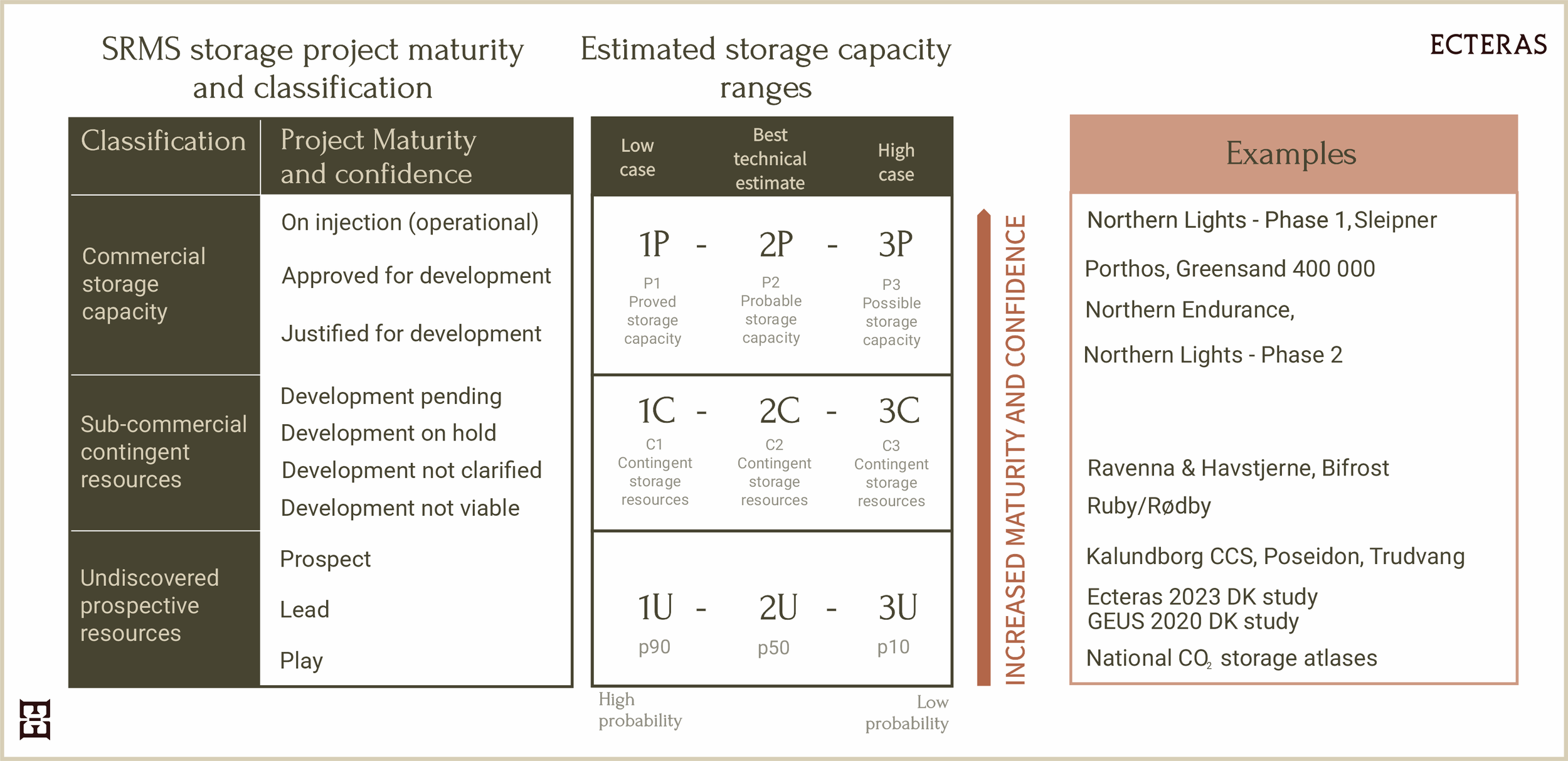Denmark just reduced their CO₂ storage estimates with 75%. Surprised? Not me. Here’s why.
Many have read the long read article we posted on LinkedIN to follow up after the story published in Politiken on the 6th of October with insights and explanations for those interested. In only ten days the article had been read 900 times. For the convenience of those searching for information we are publishing the article presenting the results of our independent evaluation of 18 potential CO₂ storage sites onshore and nearshore Denmark.
Article by Sidsel Lindsø, Advisor, geologist and CEO of Ecteras Subsurface Experts
Yesterday, the Danish newspaper Politiken published a story by journalist and Climate Editor Magnus Bredsdorff, with the title "Denmark Has Greatly Overestimated the Potential of Its Most Important Climate Fix".
The article questions Denmark’s official assessments of how much CO₂ can be stored underground. According to researchers, industry sources, and a former employee, the estimates are significantly overestimated. As a consequence, there was an official downward revision of potential in a memo from the 14th of October updating the Danish parliament, where the areas studied so far have been downgraded to a quarter of the original estimate of 12 to 22 gigaton. Critics quoted in the article believe even that may be too optimistic.
The reason why we publish our 2023 study
I accepted to be quoted in the article, where I emphasise that it is crucial for both industry, the public and policymakers to have access to realistic and updated facts - especially since CO₂ storage is a cornerstone of Denmark’s climate goals.
During the conversation I was challenged if there would ever be any CO₂ stored in Denmark, with a reference to the recent study published in Nature that apparently concluded that with the relative harsh assumptions made, Denmark would only have 130 million ton storage capacity onshore in total. We wanted to provide a bit more context and make it clear that there is considerable CO₂ storage capacity in Denmark - we just have to use the limited storage capacity available wisely.
Hence, we in Ecteras decided after a brief internal discussion to make our results of our independent subsurface study of our independent evaluation of the CO₂ storage capacity of Denmark public in the newspaper.
Why would we do so, you might think, publishing our Intellectual Property? Well, the answer is that although the results from the 2023 study cost us 3 million NOK in investment and has commercial value for us in Ecteras, we also think that it is about time that we have a calibration of hopes and ambitions so it matches reality, enabling informed strategic decisions. For a subsurface expert the official 75% reduction in CO₂ storage capacity is not new, but a small step up the maturation ladder, in a process where uncertainty is reduced.
In this article we use the opportunity to educate anyone interested in this field, and thank you for taking the time.
Results from 2023 Independent evaluation of the CO₂ storage potential nearshore- and onshore Denmark
In the overview map with the table are our CO₂ storage capacity estimates for 18 potential sites that were announced as interesting for the upcoming licensing round in 2023. For comparison, the 2020 Report No. 46 by GEUS evaluates the CO₂ storage capacity for 14 sites.
Overview map over the 18 potential CO₂ storage sites evaluated in the 2023 Ecteras study. Current licenses are highlighted by naming with license numbers and a dark outline.
Our independent study of selected potential onshore- and nearshore storage sites in Denmark uses a proxy simulation model developed by our reservoir engineer to calculate the CO₂ storage capacity. Using this we can estimate how much of the water in the reservoir we can move to create space for the CO₂, and with how many injection wells. This corresponds to modelling the CO₂ storage capacity in the dynamic domain in a simulation model. It is just more efficient and less costly, but a bit more inaccurate than actually building a simulation model. As a general rule of thumb, the results from the Proxy Model are less than 10% different than when a proper simulation model is built. Building a proper simulation model is quite costly and often takes up to half a year, involving many subsurface specialists. This is why we find it meaningful to use the tool for screening large areas for the best CO₂ storage sites.
Results from dynamic modelling for a scenario with multiple sites competing for pressure in the same aquifer, highlighting the difference between deterministic and probabilistic storage capacity estimates.
45 stratigraphic intervals were evaluated in total.
The potential storage sites that we in Ecteras currently estimate can move forward are highlighted in dark green. Note that Lisa and Jammerbugt is associated with very high uncertainty, why they may be taken out of the equation as well.
The 2020 evaluation by GEUS that concludes that the ‘mean’ estimate for the 14 storage sites is 12 gigaton is a less advanced approach, where CO₂ storage capacity is estimated in the Static Domain. This means that the potential storage space is calculated using an assumption of a CO₂ storage efficiency, meaning how much of the existing reservoir salt water one can move out of the aquifer to make space for the CO₂.
We have explained the main difference between the static and dynamic domain in this article: https://www.ecteras.com/ecteras-insights/getting-the-numbers-right
Hence, the two studies from 2020 and 2023 mainly differ in methodology. The data base is pretty much the same.
So how can it be that the difference in CO₂ storage capacity estimates are undramatic?
Let’s come back to that, but let’s first explore the world of CO₂ storage capacity classification using SRMS. It sounds hairy, but it is important and it makes sense. Bear with us for a couple of minutes worth of reading.
The SRMS (Storage Resource Management System) classification was developed by SPE (Society of Petroleum Engineers) over decades with the purpose of best representing the value of a CO₂ storage project in terms of project maturity and uncertainty ranges that are communicated to the market.
SRMS provides a standardised framework for classifying and communicating geological CO₂ storage resources. It helps stakeholders assess and communicate the maturity, feasibility, and confidence level of potential storage sites, and it guides investment and development decisions. It divides potential storage projects into Undiscovered, Contingent and Commercial.
Some say it is not perfect, but its sister system PRMS has been used for decades by banks and stock exchanges to represent the true value and inherited uncertainty in the reporting of oil and gas resources and reserves. Hence, the classification system is trusted by the entire global financial system. It works.
The reason why we like to use it is that it enables comparison between projects, and another aspect is that banks only base their financing on the Low Case Estimates, while the numbers mostly used in press releases are the High Case Estimates, because the project communicates the potential value of a project. There might be a low probability of the project succeeding, but the potential is still high.
And this is how it works: The Y-axis of the SRMS system represents project maturity and likelihood that a certain project will materialise in the future, and the X-axis represents the estimated CO₂ storage capacity ranges. We’ll come back to that, because it needs a bit more explanation which has to do with geostatisticical normal distribution, probability and deterministic estimates. But first: the Y-axis.
SRMS classification system representing technical project maturity and uncertainty in storage capacity estimate ranges. It is in the early and immature stages that storage capacity ranges change the most. Note that economics is not included.
Explaining the Undiscovered Prospective Resources category
A potential CO₂ storage project starts at the base of the classification system under Undiscovered Prospective Resources as an idea or a concept to be tested. Someone wants to understand ‘what if’ for a large area. This high-level concept is named ‘Play’ in the classification system. This falls within the Undiscovered category in the Classification, along with ‘Lead’ and ‘Prospect’. Most of the National CO2 storage atlases fall under the ‘Play’ category.
1. Play Level – The Starting Point
Definition: A Play is a broad geological region that might be suitable for CO₂ storage, based on general geological understanding.
Confidence Level: Very low. No site-specific data.
Purpose: Identifies regions worth exploring further.
2. Lead Level – A Promising Candidate
Definition: A Lead is a specific location within a Play that shows signs of being suitable for CO₂ storage. Preliminary data such as seismic surveys and old well logs suggest potential.
Confidence Level: Moderate. Some site-specific data.
Purpose: Guides decisions on where to focus more detailed studies.
3. Prospect Level – Ready for Testing
Definition: A Prospect is a well-defined site with enough data to justify drilling or testing. Detailed simulations and risk assessments have been performed.
Confidence Level: Moderate to high. Detailed site-specific data and modeling.
Purpose: Supports decisions about investing in exploration wells or pilot injection tests.
When a project has reached the Prospect level maturity, the next step requires that a license is held and permits are given for drilling an exploration well or acquiring a new seismic survey. When this step is complete, including the results from an injection test proving the injection capacity, the project can move into the Contingent resource category.
Analogies for the different maturity levels of the Undiscovered Prospective Resources category of the SRMS classification.
Explaining the Sub-commercial Contingent Resources category
Contingent Resources refer to CO₂ storage volumes that are potentially viable, but where certain conditions must be met before the level of confidence is sufficient enough that they can be classified as commercially or technically ready. These conditions might include regulatory approvals, further technical validation and financing. It is only when an FID (final investment decision) has been reached, that the project can be moved to the next category in the SRMS classification system.
4 Development Pending
Definition: The site is technically viable and has a clear development plan, but final approvals or funding are still pending.
Typical Conditions: Awaiting regulatory approval, final investment decision (FID), or environmental permits.
5 Development Unclarified or On Hold
Definition: The site has potential, but the development pathway is unclear, or the project is temporarily paused.
Typical Conditions: Uncertain market conditions, lack of clarity on project scope or technology.
6 Development Not Viable
Definition: The site is technically feasible, but current conditions make development impractical, for example, due to cost, lack of infrastructure, or policy barriers.
Typical Conditions: High costs, lack of CO₂ sources nearby, absence of transport infrastructure and unexpected changes in national and EU policy.
Analogies for the different categories in the Contingent Resources category of the SRMS classification.
Examples for real CO₂ storage projects in this category are the ones where 3D seismic data has been acquired, exploration wells have been drilled and the quality of the reservoir and associated aquifer tested with a well injection test.
With a well injection test water is injected into the target reservoir section and the results document whether the site is good enough to move forward with, or if the project should be abandoned because the reservoir quality is too poor for making the economics in the business case work. The results of evaluations will have an impact on whether the project is moved forward towards and FID (final investment decision) and a classification in the third and most mature category in the SRMS classification.
Explaining the Commercial Storage Capacity category
This category represents CO₂ storage volumes that are ready for commercial development. These sites have passed technical, regulatory, and economic hurdles and are either in operation or about to be.
7. Justified for Development
Definition: The site has been fully technically evaluated and a final investment decision (FID) has been made. All necessary approvals within the license partnership are in place and a development plan has been sent to authorities for approval.
Typical Conditions: Development plan complete, infrastructure planned, contract negotiated, and funding secured.
8. Approved for Development
Definition: The site has received formal regulatory approval of the development plan, and development is underway or imminent. Contracts are signed and the work can begin. The final thing that is missing is the Injection Permit, which involves EU and EEA member state authorities and EU oversight.
Typical Conditions: Injection wells being drilled, monitoring systems installed, and operational plans executed. This is the costly part of the project.
9. On Production (Injection)
Definition: The site has received the final injection permit and the project is actively storing CO₂. Injection is ongoing, and monitoring is in place. Injected CO₂ is classified as 1P Proved Storage Capacity. The potential most likely case is classified as 2P Probable, and the high estimate classification is named 3P Possible Storage Capacity.
Typical Conditions: CO₂ is being injected, data is being collected, and performance is being tracked.
Analogies for the different categories in the Commercial Storage Capacity category of the SRMS classification.
Explaining the X-axis of the SRMS classification
The horizontal axis of the SRMS classification represents the estimated CO₂ storage capacity ranges for the various categories for a specific project. Subsurface uncertainty is described and classified with ranges, and not single numbers. Furthermore, these ranges can be either deterministic or probabilistic.
An example is the Ecteras 2023 study results where we present a deterministic range of CO₂ storage capacity estimates for the sites that we assume are the most likely sites to be developed. In this example the scenario for these ranges is that several of the individual sites are competing for pressure in the same aquifer, assuming that all are put in production. If only one or more get access to the aquifer, the storage capacities increase.
Our deterministic estimate for the Skive site with one suitable reservoir unit is ‘as low as 5 million ton’, the ‘most likely case’ also known as ‘Best Technical Estimate’ is 18 million tons, and the ‘as high as 47 million tons’ based on the data we currently had available back in 2023.
These storage capacity ranges with selected sites that are assumed developed in the future by Ecteras have been quoted in the article in Politiken.
The most likely storage capacity of evaluated sites onshore and nearshore Denmark is 740 million ton CO₂.
If Lisa and Jammerbugt doesn’t cut it, the combined storage capacity for the selected sites will be lower. Note however, that the potential storage sites selected as interesting for the 2023 license round by GEUS exclude more structures. In addition to this the GEUS evaluation only focus on structural closures and not open aquifers.
The storage potential of Denmark’s open aquifers has not been studied yet, why the total storage capacity of Denmark is likely greater than the numbers presented here.
Probabilistic ranges are based on a statistical representation of the deterministic ranges through a normal distribution. Sounds complicated, but it is quite simple:
The overview over meaning of P90, P50, and P10 used for probabilistic ranges using a normal distribution uses a bell curve representing all possible outcomes of a CO₂ storage capacity estimate. It’s easy to get things confused here, so pay attention:
The left tail represents lower capacity outcomes. p90 means 90% probability and hence that there is a high chance (90%) that the actual storage capacity will be at least this much. It’s a conservative estimate.
The center of the curve is the P50 value — the most probable outcome. p50 means 50% probability and this is the most likely or best estimate. There’s a 50/50 chance the actual storage capacity is higher.
The right tail of the bell curve represents higher capacity outcomes. p10 means 10% probability. There is a low chance (10%) or that the actual capacity will be this high or more. It’s an optimistic estimate.
The normal distribution | The Bell Curve
The left tail represents lower capacity outcomes. p90 means 90% probability and hence that there is a high chance (90%) that the actual storage capacity will be at least this much. It’s a conservative estimate.
The center of the curve is the P50 value — the most probable outcome. p50 means 50% probability and this is the most likely or best estimate. There’s a 50/50 chance the actual storage capacity is higher.
The right tail of the bell curve represents higher capacity outcomes. p10 means 10% probability. There is a low chance (10%) or that the actual capacity will be this high or more. It’s an optimistic estimate.
Hence, probabilistic storage capacity ranges doesn’t represent the full range of expected outcomes, and the estimated ranges for the four selected sites with a competing aquifer are hence p90: 359 million ton CO₂, p50: 656 and a probability of 10% for realising 1101 million ton storage capacity in Denmark with the assumptions made.
Implications
With a basis in the SRMS classification system the 75% reduction in estimated CO₂ storage capacity for Denmark is not surprising when the basic assumptions are changed. The reason is that at this level of the project maturity a significant change in storage efficiency has a significant impact.
The main difference between the 2020 GEUS No. 46 report and the 2023 Ecteras study is that the former estimate CO₂ storage capacity in the static domain and the latter use a more advanced approach with higher confidence as the storage capacities are modelled in the dynamic domain. In addition to this, four more potential storage sites have been included in the Ecteras study, and more stratigraphic levels have been included too. Another aspect is that the Ecteras 2023 study applies a 25 year timeline.
Both approaches classify the evaluated potential CO₂ storage sites as ‘Leads’ in the SRMS classification.
The licenses awarded in Denmark can likely be classified as ‘Prospect’ in SRMS, provided that the applicants are required to have demonstrated that a reservoir simulation model has been created to simulate storage capacity and expected injection capacity. This is a requirement for a license application in Norway. What will happen next onshore Denmark is that the license owners will acquire seismic data and likely update their reservoir simulation model, qualifying to be classified as a ‘Prospect’ in SRMS. In Norway, a license can evaluate the data and decide if they will drill exploration wells and perform injection tests, or drop the license. If a well is decided upon and drilled, the specific project can be classified as a project in the Contingent Resources category.
SRMS classification and real CO₂ storage projects as examples based on independent Ecteras studies and insights.
In Denmark, however, most of the license work programs include firm commitment wells offered by the applicants because of the competitive environment. When the results from the wells and injection tests are available, the licensed potential storage sites can be classified as Contingent resources. At this stage the license owners will complete and conclude their subsurface evaluations and either relinquish the license or move forward with an FID (final investment decision).
Main take-aways from this educational article
CO2 Storage capacity estimates will change with project maturity. It is in the early stages that it changes the most, when a project moves from assumptions to real data. Hence, the reduction of 75% is a natural step in storage capacity estimates
Banks lend out financing based on the 1P, 1C or 1U categories in the SRMS classification system. Many projects, but not all, often communicate the high case potential, such as the 3U High Case, which is the lowest maturity category with the lowest probability of succeeding. An example is that 1 gigaton CO₂ storage capacity for a repurposed gas field falls under this category. It is not necessarily wrong, but it is of utmost importance for everyone, from subsurface experts to regulators to politicians to understand the difference, and which classification the storage potential that is communicated refers to.
When a project mentions CO₂ injection capacity per year, it has nothing to do with the estimated storage capacity for the site during the lifetime of the project, which can be from 15, 25 and even up to 50 years. It is possible to assume a total injection capacity of a project by multiplying the assumed injection capacity with the lifetime of the project, however, it will most likely take time to ramp up injection, and injection capacity will decrease with time as the reservoir pressure increases due to the injected CO₂ volumes. Pedantics, but important.
So how do we improve communication between subsurface experts and ‘the outside world’?
Well, it’s a two-way street: in a world where everyone is busy, it is difficult to get the time to explain complexity. We subsurface scientists are asked if we can just represent our results as a single number, because we have to simplify the message for the audience. The danger in doing so is that we over-simplify complex issues, and the result is that it ‘appears easy’. CO₂ storage is far from easy, why I continuously refuse to provide just a single number and insist on discussing ranges of storage capacities, confidence and uncertainties.
But we who know the subsurface uncertainty must also do better in educating the audience. It takes effort, no doubt about it, but here we just have to be stubborn and continue to insist on the conversation. And while doing so, we all have to get better communicating subsurface uncertainties to the wider public, and especially the politicians who set the direction and ambitions.
With this, we have made an effort. It is our hope that it has made a difference and will enable informed decision making in the CCS community.
// Sidsel
Recommended reading for more insights and context
KEF Almdel Bilag 16 GEUS orientering om CO2 lagringspotentialet for Danmarkpdf
https://www.ecteras.com/ecteras-insights/getting-the-numbers-right
https://www.ecteras.com/ecteras-insights/co2-storage-and-the-fast-moving-pressure-front
https://www.ecteras.com/ecteras-insights/aligning-on-risk-a-common-language-in-co2-storage
https://www.ecteras.com/ecteras-insights/co2-storage-5-insights-to-strengthen-your-strategy

